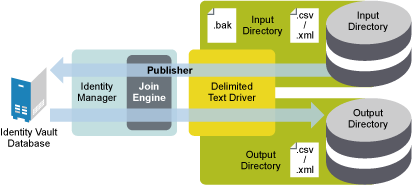1.1 How the Delimited Text Driver Works
The Delimited Text driver uses the Publisher channel, the Subscriber channel, and policies to control data flow between the Identity Vault and the delimited text files, as explained in the following sections:
1.1.1 Publisher and Subscriber Channels
The Delimited Text driver provides data flow along the Publisher and Subscriber channels as shown in the following diagram.
Figure 1-1 Data Flow

The example configuration that ships with this driver includes both Subscriber and Publisher channels. However, in many configurations, only one-way data flow is required. In those configurations, only a Publisher or Subscriber channel is used. The other channel is disabled. For more information, see Section 5.0, Setting Up One-Way Synchronization.
Publisher Channel
The Publisher channel reads information from input text files on your local file system and submits that information to the Identity Vault via the Metadirectory engine.
By default, the Publisher channel does the following:
- 1. Checks the input directory every 10 seconds.
- 2. Processes any files that have a .csv extension.
- 3. Changes .csv extensions of processed files to .bak.
- 4. Cycles through this process until you stop the driver.
Subscriber Channel
The Subscriber channel watches for additions and modifications to Identity Vault objects and creates output files on your local file system that reflect those changes.
By default, the Subscriber channel keeps an output file open until either 200 transactions have been logged or 30 seconds have elapsed. When either of these thresholds is reached, the output file is saved with a number.csv filename and a new output file is opened.
1.1.2 Policies
Policies control data synchronization between the driver and the Identity Vault. The following table provides information on the set of preconfigured policies that come with the Delimited Text driver. For information about modifying policies, see Policies in iManager for Identity Manager 3.6.1 or Policies in Designer 3.5.
Table 1-1 Preconfigured Policies
1.1.3 Delimited Text File Types
The driver currently supports two types of files:
Comma-Separated Values Files
Comma-separated value (CSV) files are text files that contain data divided into fields and records. Fields are delimited by commas, and records are delimited by a hard return.
If you need a comma or hard return within the value of a particular field, the entire field value should be enclosed in quotes.
Because the meaning of each field in a CSV file is derived from its position, each record in a CSV file should have the same number of fields. Field values can be left blank, but each record should have the same number of delimiter characters.
XML Files in XDS Format
The XDS format is the defined Novell® subset of possible XML formats. This is the initial format for data coming from an Identity Vault. By modifying default rules and changing the style sheets, the Delimited Text driver can be configured to work with any XML format.
For detailed information on the XDS format, refer to NDS DTD Commands and Events.
For information on configuring the driver to use XML files in the XDS format, see Section 6.0, Configuring for XDS XML Files.